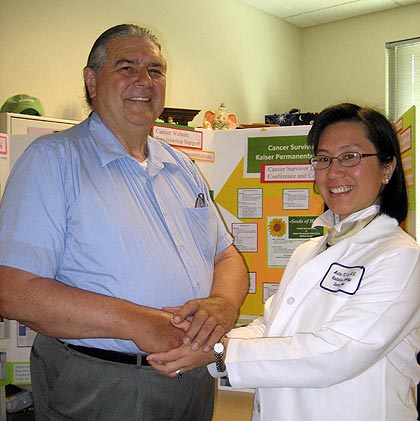
If you have seen the charming Kaiser Permanente television commercial “Where do babies come from?” you already know that, according to the kindergarten children who answer the question, “It’s complicated.”
Kaiser Permanente (KP) also recognizes that life after cancer—being a cancer survivor—is complicated. That’s why, for the second year, the HMO is sponsoring a Cancer Survivors Day Conference and Celebration in Santa Clara June 12.
“Cancer is now considered a chronic illness like, for example, diabetes,” says KP Santa Clara radiation oncologist Dr. Anita T.C. Lee. “Patients are living long enough to experience the long-term side-effects of cancer treatments and want to know what to do to keep cancer from coming back.”
“Seeds of Hope,” like those of the sunflower, is the Cancer Survivors Day 2011 theme for the conference, which is unique because of its educational emphasis. Survivors and their families can choose from 14 doctor-facilitated, 45- to 60-minute workshops on the physical, sexual, financial, and emotional issues they may face in the aftermath of their cancer treatments. The focus is on fighting cancer with food and exercise.
Lee points out that while survivors have limited control over the environment and genetics, “Diet and exercise are things they can control, and they, as patients, can make the difference themselves. However, after treatment, [studies show that] 40 percent of cancer patients return to a previous [unhealthy] lifestyle diet and lack of exercise.”
“You have to be aware of your own health and take care of yourself. The bottom line is that God created doctors to help us, but we’re the primary source of our own health,” says Kaiser member and cancer survivor John Ammon. “I need to be aware of what I need to do to take care of myself.”
“Here in Silicon Valley, people are very interested in taking care of their own health and having information,” says Lee. “We want to empower people.”
As well as a day of education, the conference will be a celebration of life with inspiring cancer survivor stories, jazz music to dance and listen to, arts and crafts, food to sample, children’s activities, and a raffle. Nutrition-related activities include cooking demonstrations by local chefs.
Kaiser’s Cancer Survivors Day Conference was inspired by the National Cancer Survivors Day (http://www.ncsdf.org). Kaiser’s conference is open first to KP members, with online registration at http://kpsantaclaracancercare.org/ limited to 400.
This cancer care website, launched in 2010, is a handy source of information for survivors. Under the cancer prevention tab, look for “8 recommendations from the American Institute for Cancer Research (AICR)” and AICR’s downloadable “Food, Nutrition, Physical Activity, and the Prevention of Cancer Summary.” Also, KP has funded a health and wellness collection at Santa Clara’s Central Park Library. View “Where do babies come from?” online at www.youtube.com.
Soon enough kindergarteners discover where babies really come from. One day they may become the medical researchers who answer the question, “Where does cancer come from?”
Kaiser Permanente’s Santa Clara Cancer Treatment Center, Department of Radiation Oncology, opened in 2006. It is the only Kaiser facility in northern California using a high-dose rate Varian Linear Accelerator to target tumors with radiation. The department serves 1,200 patients annually, 100 per day for two to six weeks, according to Dr. Brian Missett, chief of radiation oncology.





